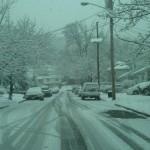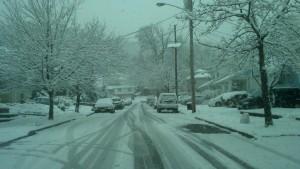

While the ice and snow can be beautiful, it is not a beautiful thing to drive in across the state of Illinois on ice and/or snow covered roadways. This last snow storm brought about much strife and stress for Illinois drivers whether it was on interstates, state highways or even driveways! The main message from the
Illinois Department of Transportation (IDOT) is to TAKE IT SLOW. Other than taking it slow, there are other things you can do right now to prepare for the next rough patch of weather.
IDOT recommends you look ahead in a number of ways/recommendations including making your vehicle winter ready, pre-trip planning, vehicle operation , stranded and back home evaluation.
Making Your Vehicle Winter Ready
During the winter, your vehicle should be in top shape because if it stalls on the road during inclement weather, you could easily become involved in a life threatening situation. To reduce these chances, winterize your car. Consult your owner's manual, reputable dealer, garage or mechanic. Winter is rough on equipment so regularly check your windshield wipers, tires, lights and fluid levels including radiator, windshield washer, power steering, oil and brakes. Make sure the transmission and brakes work properly. If you even suspect a problem, get it checked out right away
Survival Kit
Your vehicle should have a winter emergency kit and include the following items:
- Ice scraper, snow brush, rags and paper towels
- Jumper cables, basic tool kit, antifreeze, no-freeze windshield washer fluid
- Shovel, traction mats or old rugs, tire chains, salt, cat box litter or sand
- Blankets and extra clothing such as hats, socks, waterproof boots, coats & gloves
- Non-perishable high-calorie food (granola bars, protein bars, etc)
- Candles, waterproof matches and metal container (coffee can) in which to melt snow into water
- Flashlight with extra batteries, flares or roadway reflectors
- Basic first aid kit and fire extinguisher
- Cell phone with backup power source may be the single most important safety item.
Pre-trip Planning
During a winter storm, your first question before heading out on the roads is ,
"Is this trip completely necessary?".
- If you determine that you Must make the trip, check the road conditions on your route in order to give you an idea of what to expect and how to plan.
- Listen to the weather forecasts on TV, local radio, online or radio . You can get free information about interstates and freeway systems by calling 1(800)452-IDOT. Information is updated every 2 hours during a storm, or you can visit www.dot.il.gov at home or at computer monitors on interstate rest areas.
- Tell someone at home, friend or co-worker where you are going on your trip and when you expect to arrive. When you reach your destination, call them and let them know you arrived safely
- If your trip is somewhere you are not familiar, plan to travel in the daylight if possible and carry up-to-date maps, consider alternate route. Be sure you have the proper identification, registration and insurance information for your vehicle
- Before you leave town, fill your gas tank and frequently re-fill your tank. The stops relieve tense muscles from driving and keeping your car fueled prepares you in case you do become stranded and need to keep your car running for heat.
Vehicle Operation
- Buckle up--it's the law
- Be prepared to take an alternate route or seek refuge if the weather become too serious
- Use headlights on dim when driving in the rain/fog and drizzle
- If fog becomes to dense, pull off the roadway. Do not drive under 10 miles per hour
- In Rain, Sleet, Snow & Fog, do not overdrive your headlights & drive within the limits of your vision.
- Keep your windows free of snow and ice
- Drive slower and increase your following distance. You should match your speed to traffic and weather conditions
- Roadway conditions may vary depending on the sun, so look for slick spots especially under bridges
- If you start to slide, ease off the gas pedal or brakes. Steer into the direction of the skid until you feel you have regained control
- Pass snow plows with care, usually the road in front of them is not better than the road behind them.....do not pass snow plows during blowing snow
Stranded
If your vehicle breaks down, pull as far off the highway as possible. The biggest threat at this point is to be hit by other passing vehicles. Don't panic. Don't over exert physically trying to get your car unstuck. Being panicked and over exerting can lead to a condition your body cannot tolerate
- You will have to use your best judgment to determine whether or not to leave your vehicle. Gauge the temperature outside before you start walking. Temperatures as low as 20 degrees F and wind blowing 30 mph, the wind chill temperature may feel like -18 degrees F. You could suffer severe complications if have prolonged exposure or are not dressed for the extreme cold weather.
- If you are stranded in a less populated area, the response time to recue you may be lengthy. Stay in your vehicle. When you feel cold, move around as much as possible, clap your hands, shake your legs and stomp your feel. Exercise will help maintain body heat and relieve muscle tension. Sit close together and cover up with blankets or extra clothing to conserve body heat. Do not permit all occupants of the car to sleep at once
- Melt snow for drinking water. If you eat snow, it will make your body colder
- If the engine will start, run the heater for short periods of time. Partially open a downwind window to prevent carbon monoxide poisoning. Make sure the exhaust pipe is free of obstructions and the windows are not sealed by ice or snow
- If you are stranded on a well traveled road, wait for assistance from the police or other emergency personnel. Raise the hood, turn on the dome light and flasher to make your vehicle more noticeable and attach a cloth to the antenna or window indicating you need help
- Cell phone owners who see a stranded motorist can help them by calling and reporting the exact location and description of the vehicle to authorities
Back Home
When back home from a long trip, wash your vehicle to remove dirt and road salt. A coat of wax will help protect the finish against road salt. Lubricate doors and truck locks with lubricant to prevent them from freezing. And replace any items you used in your safety kit.
So, if you must drive, do so with great care. Plan before you go. Planning and preparedness can be the difference between an unpleasant experience and a nightmare. Even when we are prepared, winter driving can be hazardous. The sliding and losing of control can cause you to hit another car or another car to hit you. Collisions are always dangerous. Every winter we see a rise in car accidents, so we like to remind everyone of the safety tips to think about while driving in the winter. If you have been involved in a
car accident and if you are not sure if you need to file a personal injury claim or wonder if your insurance company is giving you a fair deal when it comes to your injuries, feel free to call our attorneys for a free consultation. Toll free (800) 685-3302 or locally (314) 276-1681

 While the ice and snow can be beautiful, it is not a beautiful thing to drive in across the state of Illinois on ice and/or snow covered roadways. This last snow storm brought about much strife and stress for Illinois drivers whether it was on interstates, state highways or even driveways! The main message from the Illinois Department of Transportation (IDOT) is to TAKE IT SLOW. Other than taking it slow, there are other things you can do right now to prepare for the next rough patch of weather.
IDOT recommends you look ahead in a number of ways/recommendations including making your vehicle winter ready, pre-trip planning, vehicle operation , stranded and back home evaluation.
While the ice and snow can be beautiful, it is not a beautiful thing to drive in across the state of Illinois on ice and/or snow covered roadways. This last snow storm brought about much strife and stress for Illinois drivers whether it was on interstates, state highways or even driveways! The main message from the Illinois Department of Transportation (IDOT) is to TAKE IT SLOW. Other than taking it slow, there are other things you can do right now to prepare for the next rough patch of weather.
IDOT recommends you look ahead in a number of ways/recommendations including making your vehicle winter ready, pre-trip planning, vehicle operation , stranded and back home evaluation.
